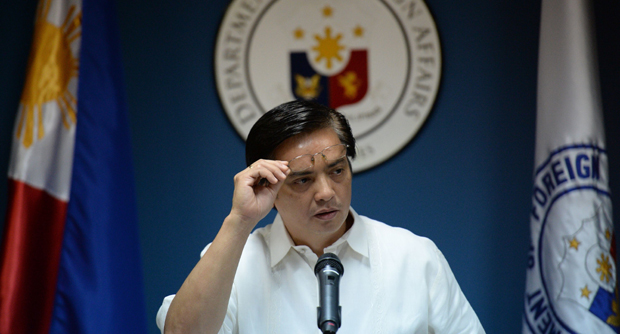MANILA, Philippines—The resolution of the longstanding maritime dispute between the Philippines and Indonesia over waters off the country’s southern tip is a “good example” of how nations can peacefully settle border issues, according to a foreign affairs official.
“It’s very important because I think given the recent situation where we have overlapping disputes, this is an example of a peaceful way to reach an agreement on how you can [resolve a dispute],” said Assistant Secretary Charles Jose, spokesman of the Department of Foreign Affairs (DFA), in a statement, apparently referring to the Philippines’ disputes with China over territories in the South China Sea.
By way of contrast, Jose underscored the importance of the Philippines and Indonesia having clarified the demarcations of their exclusive economic zone (EEZ) in the waters between the Mindanao and Celebes Seas.
“This was the maritime boundary delimitation. There was an overlapping EEZ between the Philippines and Indonesia in the Celebes Sea and Mindanao Sea. So the boundary that we are talking about is all on water,” Jose explained.
Rich fishing grounds
The DFA announced last Monday that the Philippines and Indonesia had concluded in Jakarta over the weekend the final text of an agreement setting the delimitation of the two countries’ EEZ between the Mindanao and Celebes Seas, clarifying overlapping zones where they could exercise sovereignty.
The area is known to be rich traditional fishing grounds for fishermen from General Santos and Sarangani and the Davao region, said Jose.
After 20 years
The resolution ended following 20 years of negotiations, the DFA said.
The Philippines’ EEZ dispute with Indonesia does not involve territories (land or rock forms). By comparison, its dispute with China in the South China Sea does not involve EEZ demarcations but is centered on the Chinese so-called “nine-dash line” claim, which extends well beyond its EEZ and encompasses some 90 percent of waters and territories within the contested waters.
“In the case of China, there is no overlapping EEZ, so there’s nothing to demarcate. It’s very clear from provisions of Unclos where our EEZ starts and ends, and where China’s EEZ starts and ends. And when you project the EEZ of each country from their land mass, there’s no overlap,” explained Jose.
“Maybe China has to first drop its claim of indisputable sovereignty [over the South China Sea] before we can demarcate our overlapping claims,” said Jose.
Good example
He said the Philippine-Indonesia EEZ pact—resolved through talks in contrast with the tense South China Sea row—would serve as proof that nations can settle border problems quietly.
“It’s a good example. It took us 20 years to conclude the negotiations. So we can be assured that we have patience, that we can negotiate that long,” said Jose.
Philippine and Indonesian officials endorsed the EEZ agreement for signing during meetings over the weekend, when diplomats, hydrographers and cartographers from both sides drafted the final text and details of the map showing the EEZ limits.
Jose said the pact is expected to be signed “at the earliest opportunity,” though it is unlikely to be set during the state visit here of Indonesian President Susilo Bambang Yudhoyono this week in conjunction with his participation in the World Economic Forum on East Asia.
Equitable delimitation
A chart showing the demarcation line has already been drawn but could only be released after the signing of the agreement, Jose said.
He said the EEZ lines were set in a manner “equitable” to both sides.
“The overarching principle is equitable delimitation. Because, you will note, the boundary points are not always equidistant, not always in the median. Some parts we get bigger for the Philippines, some parts Indonesia got were bigger. But overall, it’s equitable,” said Jose.
He did not discuss details on whether there were thorny aspects of the talks that began in 1994 in deference to the pact’s signing.
Asked how the Philippines plans to enforce the EEZ boundary, Jose said the government will implement an information campaign to let Filipino fishermen know how far they can go in the area.
“At least with this agreement, it will be clear for both sides how far they we could go where we can exercise our rights and obligations under Unclos,” said Jose.
RELATED STORY
Philippines, Indonesia reach pact on sea dispute


